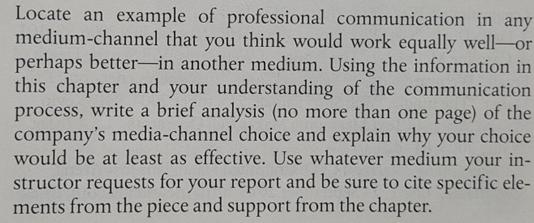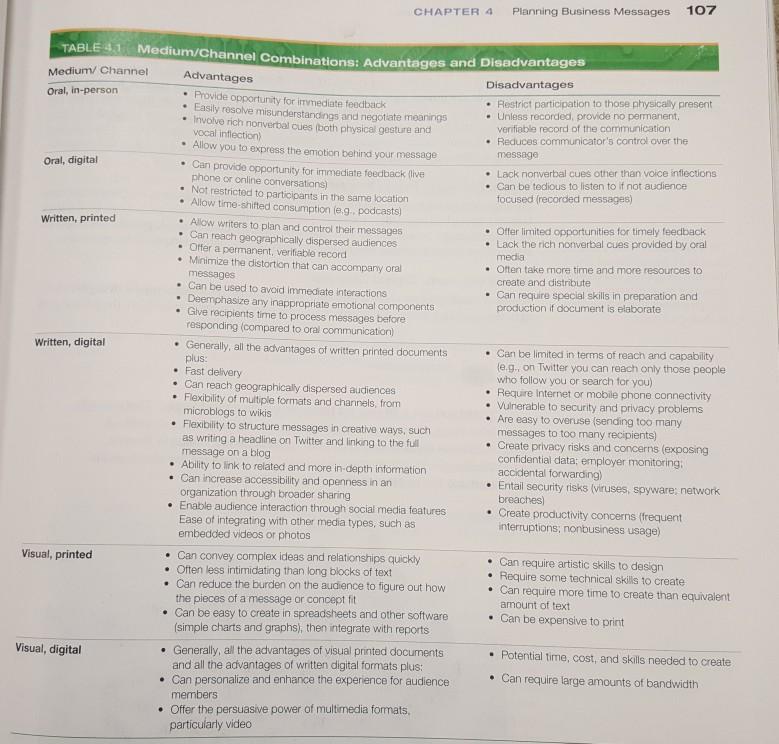Answered step by step
Verified Expert Solution
Question
1 Approved Answer
Locate an example of professional communication in any medium-channel that you think would work equally well-or perhaps better-in another medium. Using the information in




Locate an example of professional communication in any medium-channel that you think would work equally well-or perhaps better-in another medium. Using the information in this chapter and your understanding of the communication process, write a brief analysis (no more than one page) of the company's media-channel choice and explain why your choice would be at least as effective. Use whatever medium your in- structor requests for your report and be sure to cite specific ele- ments from the piece and support from the chapter. ng e Three-Step Wting Procei Selecting the Best Combination of Media and Channels With the necessary information in hand, your nest decision involves the best combina tion of media and channels to reach yur target audience As you recall from Chapter i the medium is the kim a mesage takes and the channel is the sytem used to deliver the message. The distinction betwcen the two isnt always crystal clear, and some prople use the terms in dilferent ways but theve definitions are uselul way sibilities for business communication Most media can be distributed through more than one channel, so whenever you have a choice, think through vour options to select the optimum combination. For example, brief writtem message could he ilistributed as a printed letter or memo, or it could be dis ributed through a variety of digital channels, from email to blogging to social networking think about the pos- THE MOST COMMON MEDIA AND CHANNEL OPTIONS The simplest way to categorze media choices is to divide them into onal (spokeni, wr An, and visal lach of these media can be delvered through digital and nondigital channs which creates sis bask combinations, discussed in the following sections. Tahle 4.1 sum- marizes the general advantages and disadvantages of the SIK medium channel combina tiens. Specific options within these categories have their own strengihn and weaknesses to consider as well, Fot simplicity's sake subsequent chapcers occasionally use "digital meda ta indicate any of the ihre media types delivered through digital channels) Oral Medium, in-Person Channel The oral mediium, in-person combu involves talking with people who are in the same Jocation, whether it's a orve-on-one conversation over lunch or a more formal spcech or presentation. Being in the same physical space is a key distinction becinase it enables the nuances of nonverhal commuunication mare than any other media-channel combo. As Chapter 2 points out, these nonverbal signals can carry as much weight in the conversa- tlon as the words being spoken. By ang people the ability to see, hear, and neact to each other, in-person commu nication is seful for encourging people to ask questions, make commens, and work together to reach a consensus or derision. Face-to-face interaction is particularly helpful in complex, emotionally charged situations in which eatablishing or fostering a business relationship is important." Managers who engage in frequent "walk-arounds," chatting with employees face-to-face, can get input, answer questions, and interpret important business events and trends. Oral Medium, Digital Channel Oral media via digital channels include any transmission of voice via electronic means hoth live and reconded, including telephone calls. podcasts, and voicemail messaoes Live phone conversations offer the give-and-take of in-person conversations and can he the best alternative to talking in person. However, willhout a video component, they u't urovide the nuances of nomverbal coimunication. Podcasts can be a good way to share lectures, commentary, and other spoken content. You can read about podcastiny in Chapter 7 Written Medium, Print Channel Written, printed documents are the classic format of business comminication. Memer are brief printed documents traditionally used for the routine, day-to-day exchanoe of information wichin an arganization. Letters are briet written messages sent to casteim and other recipiemts qutside the orginization. Reports and proposals are usually lonere than memos and letters, although both can be created in memo or letter format. T documents come in a variety of lengths, ranging Irom a few pages to several hundred are usually fairly formal in tone CHAPTER 4 Planning Business Messages 107 TABLE 41 Medium/Channel Combinations: Advantages and DisadvantageS Medium/ Channel Advantages Disadvantages Restrict participation to those physically present Unless recorded, provide no permanent, verifiable record of the communication Reduces communicator's control over the message Oral, in-person Provide opportunity for immediate feedback Easily resolve misunderstandings and negotiate meanings Involve rich nonverbal cues (both physical gesture and vocal inflection) Allow you to express the emotion behind your message Lack nonverbal cues other than voice inflections Can be tedious to listen to if not audience focused (recorded messages) Oral, digital Can provide opportunity for immediate feedback (live phone or online conversations) Not restricted to participants in the same location Allow time-shifted consumption je.g, podcasts) Offer limited opportunities for timely feedback Lack the rich nonverbal cues provided by oral Allow writers to plan and control their messages Can reach geographically dispersed audiences Offer a permanent, verifiable record Minimize the distortion that can accompany oral Written, printed media Often take more time and maore resources to messages Can be used to avoid immediate interactions Deemphasize any inappropriate emotional components Give recipients time to process messages before responding (compared to oral communication) create and distribute Can require special skills in preparation and production if document is elaborate Generally, all the advantages of written printed documents plus: Fast delivery Can reach geographically dispersed audiences Flexibility of multiple formats and chaninels, from microblogs to wikis Flexibility to structure messages in creative ways, such as writing a headline on Twitter and linking to the full message on a blog Ability to link to related and more in-depth information Can increase accessibility and openness in an organization through broader sharing Enable audience interaction through social media features Ease of integrating with other media types, such as embedded videos or photos Can be limited in terms of reach and capability (e.g., on Twitter you can reach only those people who follow you or search for you) Require Internet or mobile phone connectivity Vulnerable to security and privacy problems Are easy to overuse (sending too many messages to too many recipients) Create privacy risks and concerns (exposing confidential data; employer monitoring: accidental forwarding) Entail security risks (viruses, spyware; network Written, digital breaches) Create productivity concerns (frequent interruptions; nonbusiness usage) Can convey complex ideas and relationships quickly Often less intimidating than long blocks of text Can reduce the burden on the audience to figure out how the pieces of a message or concept fit Can be easy to create in spreadsheets and other software (simple charts and graphs), then integrate with reports Can require artistic skills to design Require some technical skills to create Can require more time to create than equivalent Visual, printed amount of text Can be expensive to print Generally, all the advantages of visual printed documents and all the advantages of written digital formats plus: Can personalize and enhance the experience for audience Visual, digital Potential time, cost, and skills needed to create Can require large amounts of bandwidth members Offer the persuasive power of multimedia formats, particularly video Written Medium, Digital Channel Most of your business communication efforts will involve written digital messages, with everything from 140-character tweets to website content to book-length reports distributed as portable document format (PDF) files (see Figure 4.4). Business uses of written, digital messages keeps evolving as companies look for ways to communicate more effectively. For example, email has been a primary business medium for the past decade or two, but it is being replaced in many cases by a variety of other digital formats.* Chapter 7 takes a closer look at various written-digital combinations, from email to instant messaging (IM) to social networks. Visual Medium, Print Channel Photographs and diagrams can be effective communication tools for conveying emotional content, spatial relationships, technical processes, and other content that can be difficult to describe using words alone. You may occasionally create visual, printed messages as stand-alone items, but most will be used as supporting material in printed documents. Visual Medium, Digital Channel Business messages can really come alive when conveyed by visual media in digital chan- nels. Infographics, interactive diagrams, animation, and digital video have the potential to
Step by Step Solution
★★★★★
3.34 Rating (160 Votes )
There are 3 Steps involved in it
Step: 1

Get Instant Access to Expert-Tailored Solutions
See step-by-step solutions with expert insights and AI powered tools for academic success
Step: 2

Step: 3

Ace Your Homework with AI
Get the answers you need in no time with our AI-driven, step-by-step assistance
Get Started


